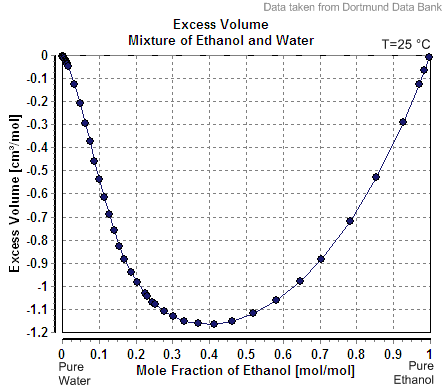Volume Ratio on:
[Wikipedia]
[Google]
[Amazon]
In
''Volume-volume percentage''Chembuddy
website The percentage by volume (vol%) is one way of expressing the composition of a mixture with a In the case of a mixture of ethanol and water, which are
In the case of a mixture of ethanol and water, which are
chemistry
Chemistry is the science, scientific study of the properties and behavior of matter. It is a natural science that covers the Chemical element, elements that make up matter to the chemical compound, compounds made of atoms, molecules and ions ...
and fluid mechanics, the volume fraction φ''i'' is defined as the volume of a constituent ''V''''i'' divided by the volume of all constituents of the mixture ''V'' prior to mixing:
:
Being dimensionless, its unit is 1; it is expressed as a number, e.g., 0.18. It is the same concept as volume percent (vol%) except that the latter is expressed with a denominator of 100, e.g., 18%.
The volume fraction coincides with the volume concentration in ideal solution
In chemistry, an ideal solution or ideal mixture is a solution that exhibits thermodynamic properties analogous to those of a mixture of ideal gases. The enthalpy of mixing is zero as is the volume change on mixing by definition; the closer to zero ...
s where the volumes of the constituents are additive (the volume of the solution is equal to the sum of the volumes of its ingredients).
The sum of all volume fractions of a mixture is equal to 1:
:
The volume fraction (percentage by volume, vol%) is one way of expressing the composition of a mixture with a dimensionless quantity
A dimensionless quantity (also known as a bare quantity, pure quantity, or scalar quantity as well as quantity of dimension one) is a quantity to which no physical dimension is assigned, with a corresponding SI unit of measurement of one (or 1) ...
; mass fraction (percentage by weight, wt%) and mole fraction (percentage by moles, mol%) are others.
Volume concentration and volume percent
Volume percent is the concentration of a certain solute, measured by volume, in a solution. It has as a denominator the volume of the mixture itself, as usual for expressions of concentration, rather than the total of all the individual component's volumes prior to mixing: : : Volume percent is usually used when the solution is made by mixing twofluid
In physics, a fluid is a liquid, gas, or other material that continuously deforms (''flows'') under an applied shear stress, or external force. They have zero shear modulus, or, in simpler terms, are substances which cannot resist any shear ...
s, such as liquids or gases. However, percentages
In mathematics, a percentage (from la, per centum, "by a hundred") is a number or ratio expressed as a fraction of 100. It is often denoted using the percent sign, "%", although the abbreviations "pct.", "pct" and sometimes "pc" are also u ...
are only additive for ideal gases.website The percentage by volume (vol%) is one way of expressing the composition of a mixture with a
dimensionless quantity
A dimensionless quantity (also known as a bare quantity, pure quantity, or scalar quantity as well as quantity of dimension one) is a quantity to which no physical dimension is assigned, with a corresponding SI unit of measurement of one (or 1) ...
; mass fraction (percentage by weight, wt%) and mole fraction (percentage by moles, mol%) are others.
 In the case of a mixture of ethanol and water, which are
In the case of a mixture of ethanol and water, which are miscible
Miscibility () is the property of two substances to mix in all proportions (that is, to fully dissolve in each other at any concentration), forming a homogeneous mixture (a solution). The term is most often applied to liquids but also applies ...
in all proportions, the designation of solvent and solute is arbitrary. The volume of such a mixture is slightly less than the sum of the volumes of the components. Thus, by the above definition, the term "40% alcohol by volume" refers to a mixture of 40 volume units of ethanol with enough water to make a final volume of 100 units, rather than a mixture of 40 units of ethanol with 60 units of water. The "enough water" is actually slightly more than 60 volume units, since water-ethanol mixture loses volume due to intermolecular attraction.
Relation to mass fraction
Volume fraction is related to mass fraction, by where is the constituent density, and is the mixture density.See also
*Alcohol by volume
Alcohol by volume (abbreviated as ABV, abv, or alc/vol) is a standard measure of how much alcohol (ethanol) is contained in a given volume of an alcoholic beverage (expressed as a volume percent). It is defined as the number of millilitres (mL) o ...
* Alcohol meter
* Alcohol proof
* Apparent molar property
* For non-ideal mixtures, see Partial molar volume and Excess molar quantity
* Percentage
In mathematics, a percentage (from la, per centum, "by a hundred") is a number or ratio expressed as a fraction of 100. It is often denoted using the percent sign, "%", although the abbreviations "pct.", "pct" and sometimes "pc" are also us ...
* Mass fraction (chemistry)
References
{{Chemical solutions Dimensionless numbers of chemistry Physical chemistry Thermodynamics Analytical chemistry